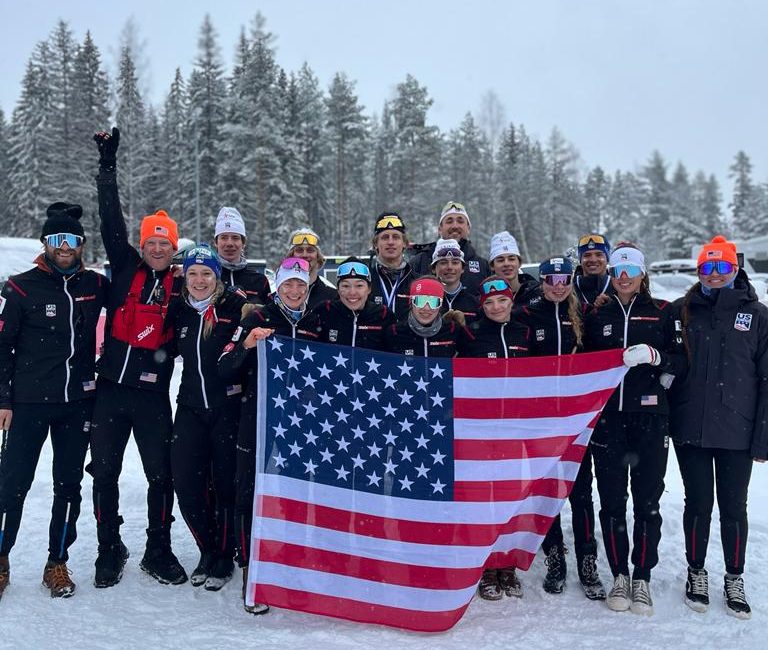
It was the end of the weekend, but the start of a whole new generation of Americans skiers on the World’s stage. Tabor Greenberg, the Green Mountain Valley School attendee and a U16 national champion last season pulled into the final kilometer of a 3 x 5km Team Relay, locked stride-for-stride with the familiar red suit of his Norwegian counterpart. The stadium was ahead, and for the first time clad in a US Ski Team suit, Greenberg would get a chance to sprint for an international win. The duo entered the stadium in Jyvaskyla, Finland—the self-proclaimed “Capital of Finnish Sport” and the host for this year’s Nordic Nations’ Cup. The stadium was set up in true World Cup style, one giant 180 degree turn into a final sprint. The pairing entered the turn together, but by the time they exited, only one skier was still on their skis. A Norwegian stumble left Greenberg to brace for the impact of the finish line, where he entered the arms of his teammate, Fin Bailey. Team USA, the youngest edition, had ended their first weekend of international racing with a team win. Thus the team relay—an event that has served as the literal incarnation of US skiing’s team-oriented development philosophy—served as a poignant highlight to a weekend with the purpose of fostering that philosophy in the next generation of American skiers.
Nordic Nations’ Cup Trip
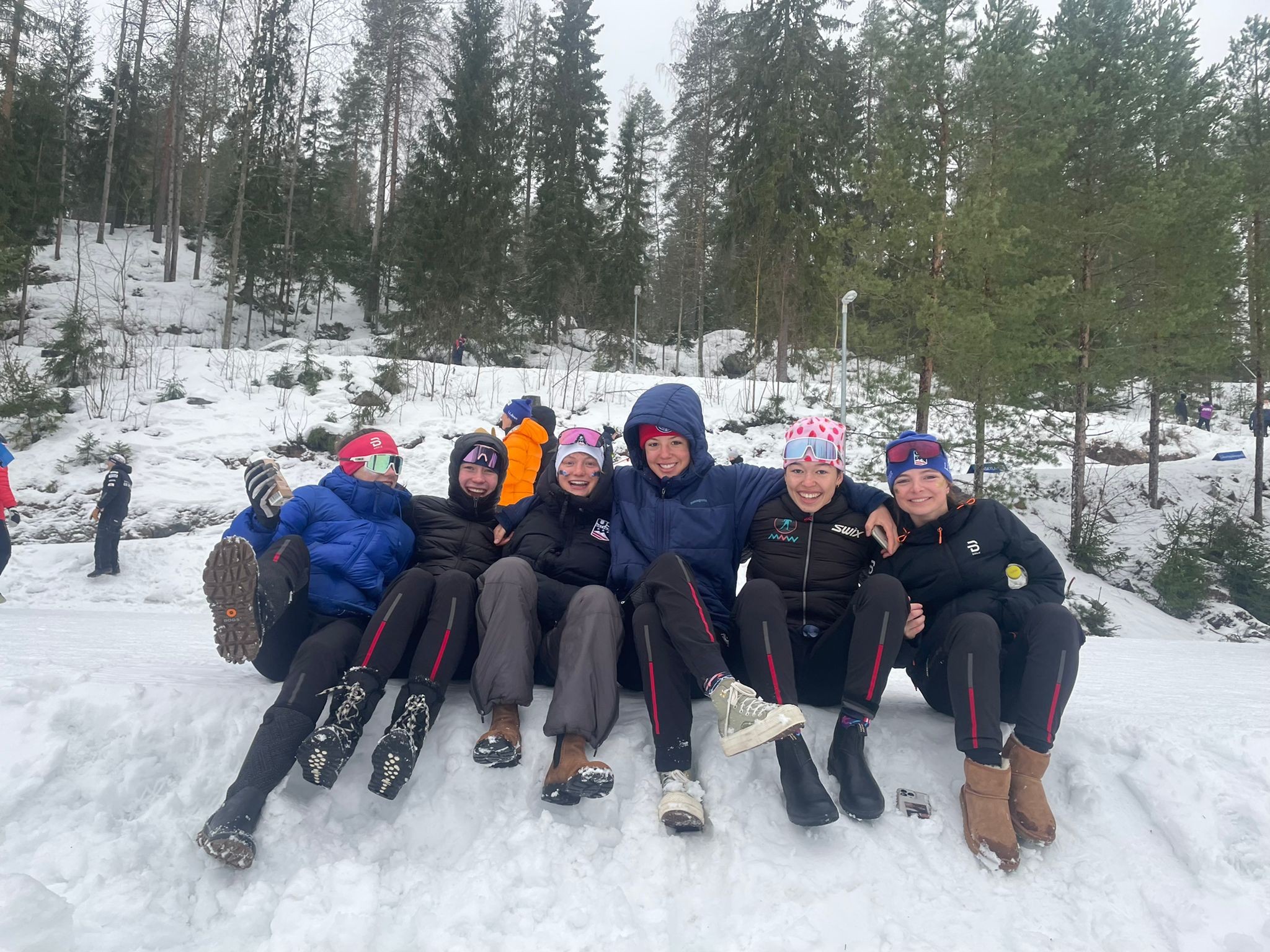
The US Ski Team and National Nordic Foundation have sent a delegation of U18 skiers to the Nordic Nations’ Cup, a joint competition between Norway, Sweden, Finland, and Estonia (formerly the Scandinavian Cup), as part of their developmental program for years. The trip serves as an introduction to both international racing, and the unique demands placed on American athletes to do so in a primarily European sport, to promising American U18 athletes. It also serves as an exchange of skiing traditions between the nordic ski communities of the Scandinavian Peninsula and the United States. The trip has previously served as an introduction to international racing for US Ski Team members such as Ben Ogden, Julia Kern, Katharine Ogden, and Hannah Halvorsen.
The year’s Nordic Nations’ Trip took on a special significance too, in that it marked the resumption of the trip for the first time since the COVID pandemic began in 2020. The qualifying athletes on Team USA represented a steadfast group of racers who had come of age in the sport through the challenges of canceled races and day-to-day restrictions of the past few years. They had remained dedicated, they had progressed in the sport, and now they were getting their chance to enter the world’s stage together.
Last week, they traveled to the heart of Finland’s lake region in Jyvaskyla, and got ready to race a full World Cup-style race schedule that began with a Classic Individual Sprint Friday, before moving to a 10k / 5k Individual Start Freestyle Saturday, and finishing with a 3x5k / 3×3.3k Team Relay Sunday. Previously, the best individual result at the Nordic Nations’ Cup for a US athlete came from Hannah Halvorsen, who finished third in the 5 k Skate in 2015. Likewise, Halvorsen combined with Kern and Ogden to podium in the Team Relay that year. In 2023, a new generation would look to build off past successes for the US while blazing their own trail through the Finnish Northwoods in a jam-packed weekend.
The results? Well, as US Coach Colin Rodgers (Green Mountain Valley School) would summarize in comments after the weekend, “What we learned, from watching them race and from a little historic research, is that both the men and women as a whole performed very well.”
Classic Individual Sprint

The weekend began with a fast and furious Classic sprint. The US team qualified six athletes across the boys and girls field: Finn (Finegan) Bailey (5th), Owen Young (13th), Grey (Benjamin) Barbier (16th), and Landon Wyatt (25th) for the Boys, and Neve Gerard (25th) and Sydney Drevlow (30th) for the Girls.
In the Girls’ quarterfinals, both Gerard and Drevlow skied with poise in their first international heats. Drevlow got off the line with a good start in her heat, tucking into third place before losing contact with the lead group that formed later in the heat. Gerard followed similarly, but held on to the pairing of Marie Wollan Benum (NOR) and Ellinor Halonen (FIN) into the final stretch, finishing third in her heat.
In the Boys’ quarterfinal, three of the four American qualifiers raced in the same quarterfinal, Bailey, Barbier, and Wyatt all toeing the line. Barbier led the early charge for the Americans, following leader Maans Ravald (SWE) in the first part of the course. Bailey eventually put a charge in to ski up to Barbier, with the pairing skiing tucking into the stadium together. Ravald would win the heat, and Bailey would outsprint his teammate to advance to the semifinals. Wyatt finished fifth in the heat. In his quarterfinal, Owen Young took an approach that echoed Ben Ogden in Val di Fiemme during this year’s Tour de Ski—pushing the pace from the start. Young’s efforts had the intended effect, with the field pushing an aggressive pace through the middle of the course. Young himself looked to be fading, but when the quarterfinal entered the stadium he had surged again to put himself in contact with the field. He ended up in fifth in the heat, closing in on fourth place as they crossed the line.
Bailey, then, was the only American to advance to the semifinals, where he finished second in the heat and moved into the finals. When he got there, he matched up against the full array of the Nordic Nations—Norway, Sweden, Finland, and Estonia all present. He opted to hop behind the Norwegian, Eling Broberg, from the start. Broberg wore bib 1, and had taken the field out hard and within a half-kilometer, had gapped the rest of his competitors. Bailey stayed in the pack that came into the stadium together, following Anton Packalen (FIN) and Toni Andree Saarepuu (EST). In a tightly packed final turn, Bailey was forced to the outside of the track, where he would put an all-out double-pole to pull back to contend for third. He ran out of track for his efforts, and finished fourth place on the day. With it, Bailey notched a result that would serve both as an achievement in its own right, and an auspicious sign of things to come for the weekend.
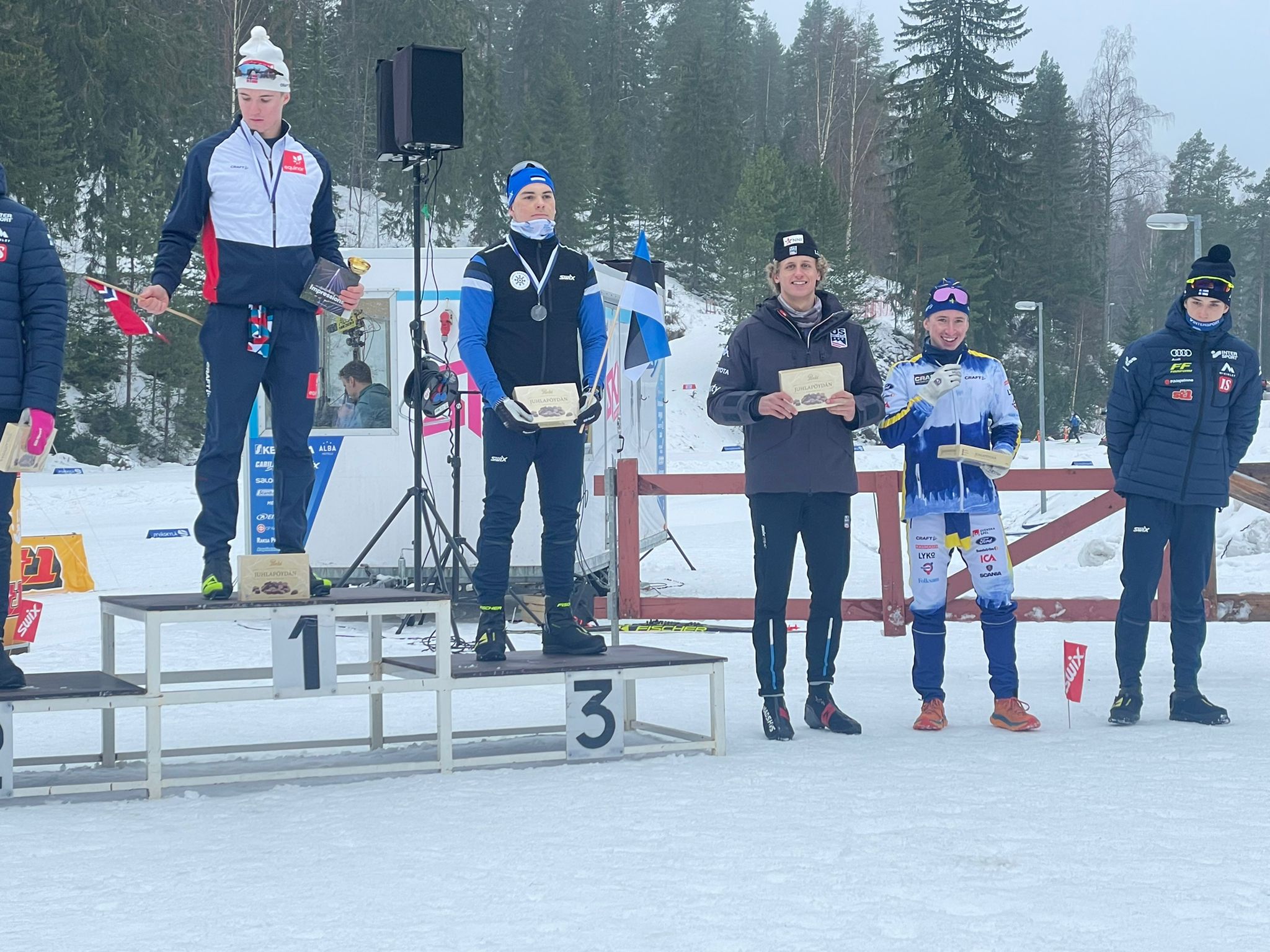
10k/5k Individual Start Freestyle
The next day, skiers switched gears to line up for a skate distance race. The Boys would complete a 10 k, while the Girls competed in a 5 k. The Girls field went out first, with Sydney Drevlow, Neve Gerard, Rose Horning, and Lena Poduska all starting in relatively close proximity to one another. Relative, that is, to where they would finish on the day.
In a tightly packed results sheet, four American girls would finish within six seconds of each other to go 8th-11th place. The order: 8th) Sydney Drevlow, 9th) Neve Gerard, 10th) Rose Horning, and 11th) Lena Poduska. The quadruple was a novelty: skiers normally separated by a continent finishing within seconds of each other on a race course half a world away from home. Delaney Jackson and Ally Wheeler weren’t far behind, finishing 24th and 27th, respectively. In watching the race unfold, US coach Will Wicherski (Jackson Hole) said, “I was on course at 2k giving splits and it was obvious from how all the girls were skiing that they would be up at the top…we knew it was going to be an impressive team performance!”
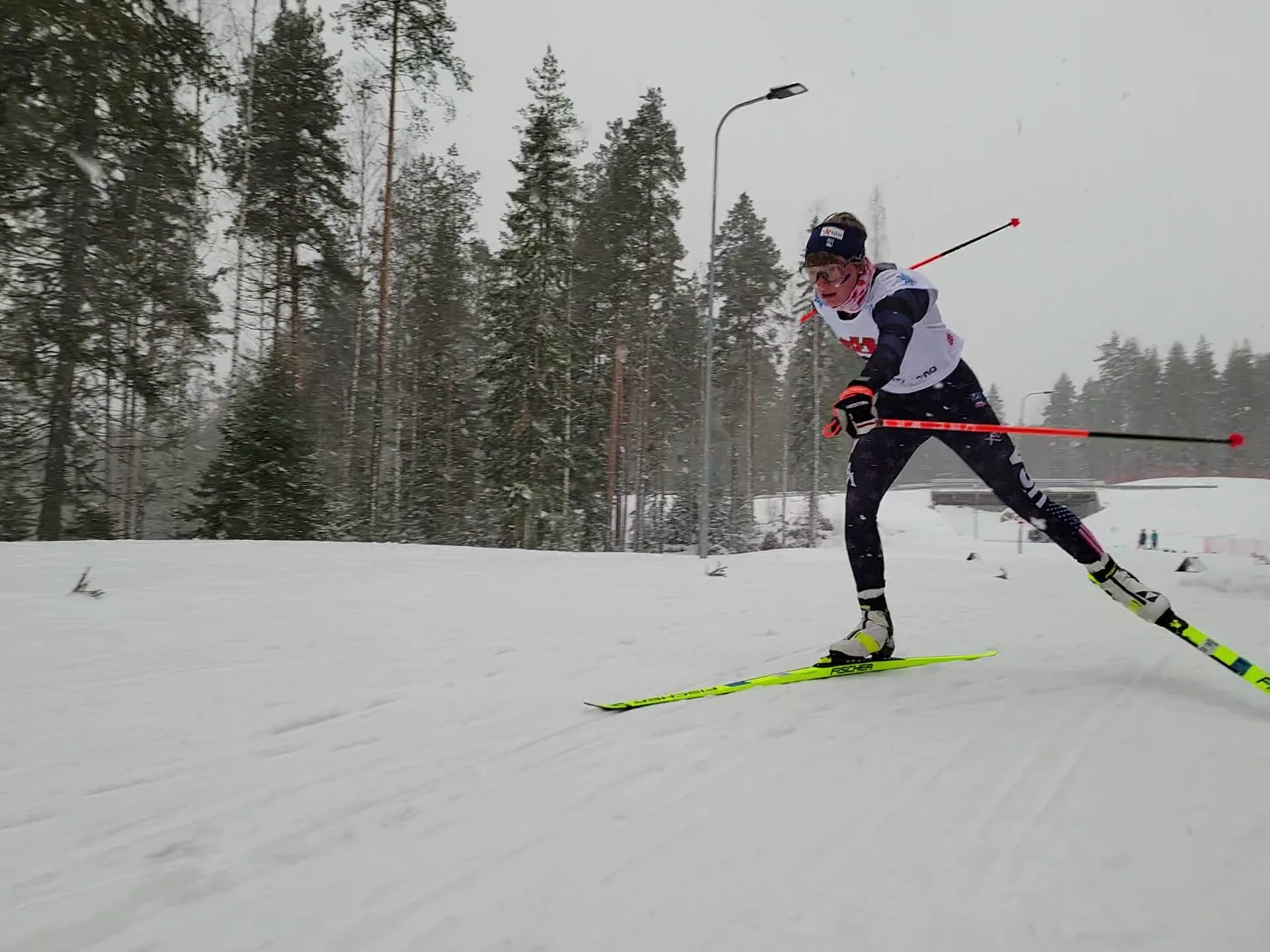
The Boys’ field followed the girls out onto the Jyvaskyla course. Wyatt was the first American on course from Team USA. Davis Isom and Owen Young followed, with Greenberg and Bailey finishing out the start list for the Americans.
In another tightly packed race, the news from the Americans kept getting better and better. Wyatt finished with a time that would eventually net him 24th place on the day. Then Isom came across with a time just 20 seconds off the fastest time of the day so far in second. It would eventually turn out to be a top 10 performance. Young followed to slot in between Wyatt and Isom, finishing 20th place on the day.
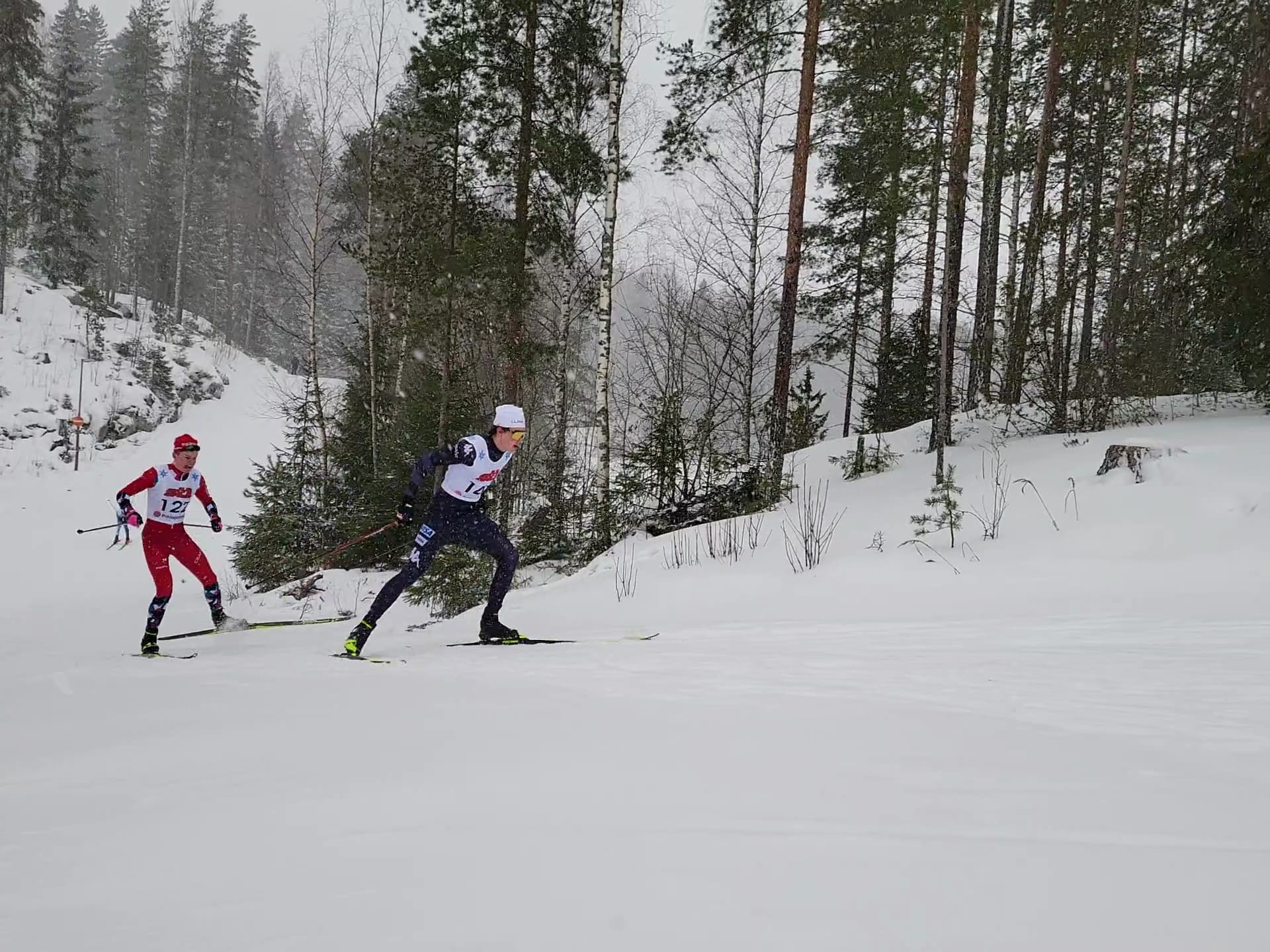
Behind those early finishers, Tabor Greenberg was knocking down each checkpoint in the fastest time of the day. He tucked and weaved out of the packs that had formed throughout the course, but was skiing a race, in a league, of his own. When he crossed the finish line, his 23:04.9 stood fastest on the day so far. As finishers continued to roll in, Greenberg’s time kept standing. Bailey came in fast, 33 seconds off his teammate, which would land him in sixth place. Barbier came in 53 seconds off Greenberg, and would get 16th on the day. Greenberg had won the race. In doing so, the young Vermonter became the first American athlete to win at the Nordic Nations’ Cup, and it was only day two.
3x5k/3×3.3k Team Relay
The culminating experience for this, and any, U18 Nordic Nations’ Trip came on Sunday. For the young members of Team USA, it was here: their first “relay day.” That moniker, “relay day,” has come to denote something special for US skiing. Careful planning, team spirit, stars and stripes, and, of course, glitter. It was time.
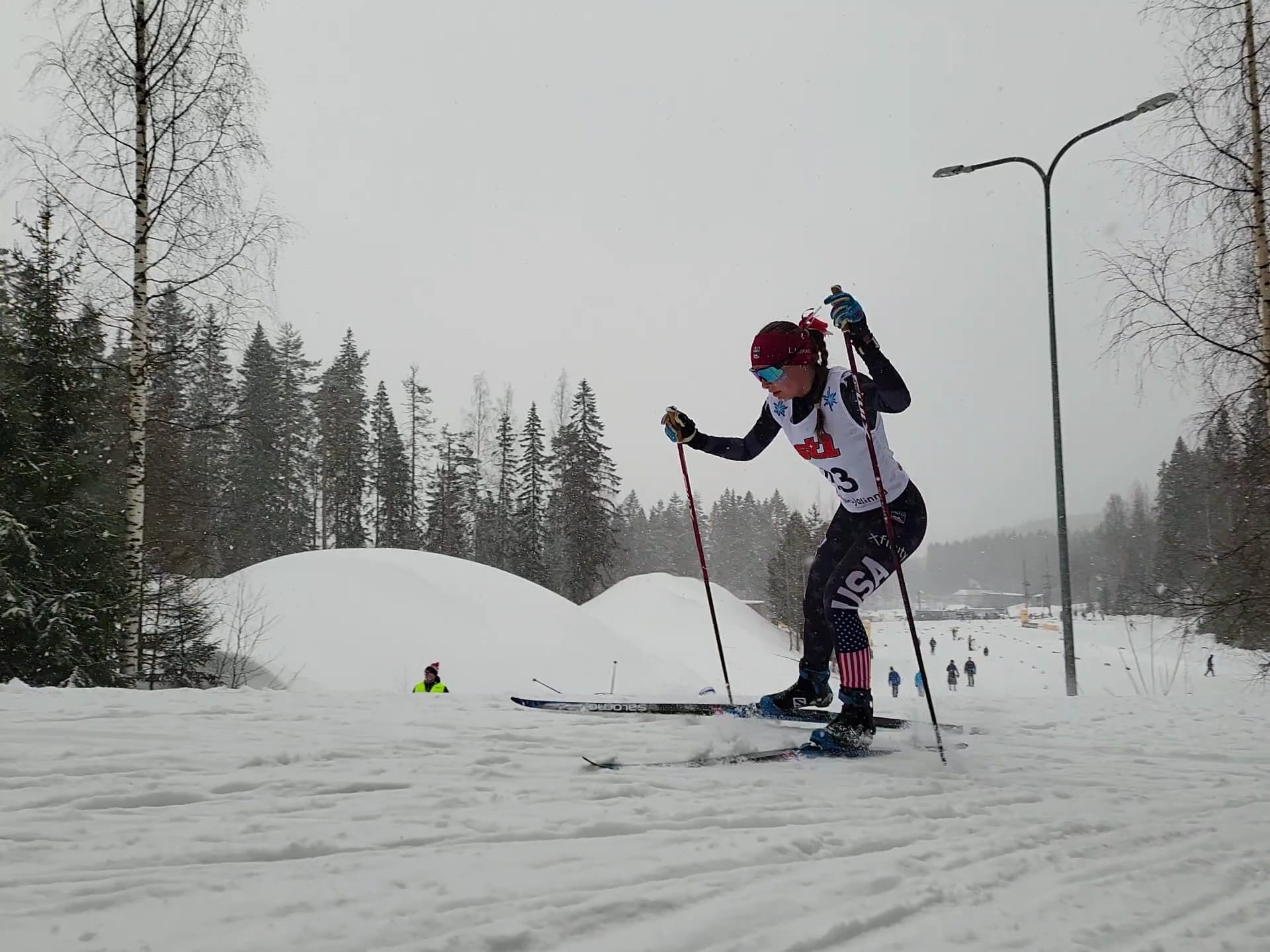
The US sent two trios out for the Girls 3 x 3.3k. Lineup for Team 1: Sydney Drevlow skiing classic in the first leg, Rose Horning in the first of two freestyle legs in second, and Neve Gerard anchoring. Lineup for Team 2: Lena Poduska in the first leg, Ally Wheeler second leg, and Delaney Jackson anchoring.
The first classic leg saw the girls field open up, with Norway, Sweden and Finland all taking turns leading the field. Drevlow remained in the front pack, with Poduska holding on to keep both US teams in contention for the race going into leg 2. The race had closed again in leg 2, with Rose Horning and Ally Wheeler skiing fourth and fifth place in a large field. The hand-off to the anchor legs was when the field started to stretch out. Norway won the day, with Sweden edging out Finland for second and third, respectively. 15 seconds off that chaos though, Neve Gerard had closed her all-around strong weekend with a strong leg, skiing USA Team 1 to a fourth place finish. Delaney Jackson gave USA 2 a final boost to finish in eighth place.
The boys’ lineups would include two teams as well. Team 1 saw Bailey on the first leg, Barbier taking the handoff for the second leg, and Greenberg playing anchor. As US coach Will Wicherski explained, “Fin had a fantastic classic sprint sprint, Tabor had won the day before, and Grey had been skiing really well all week so we put him in the middle leg.” Team 2 included Wyatt for the first leg, Young for the second leg, and Isom in the anchor role.
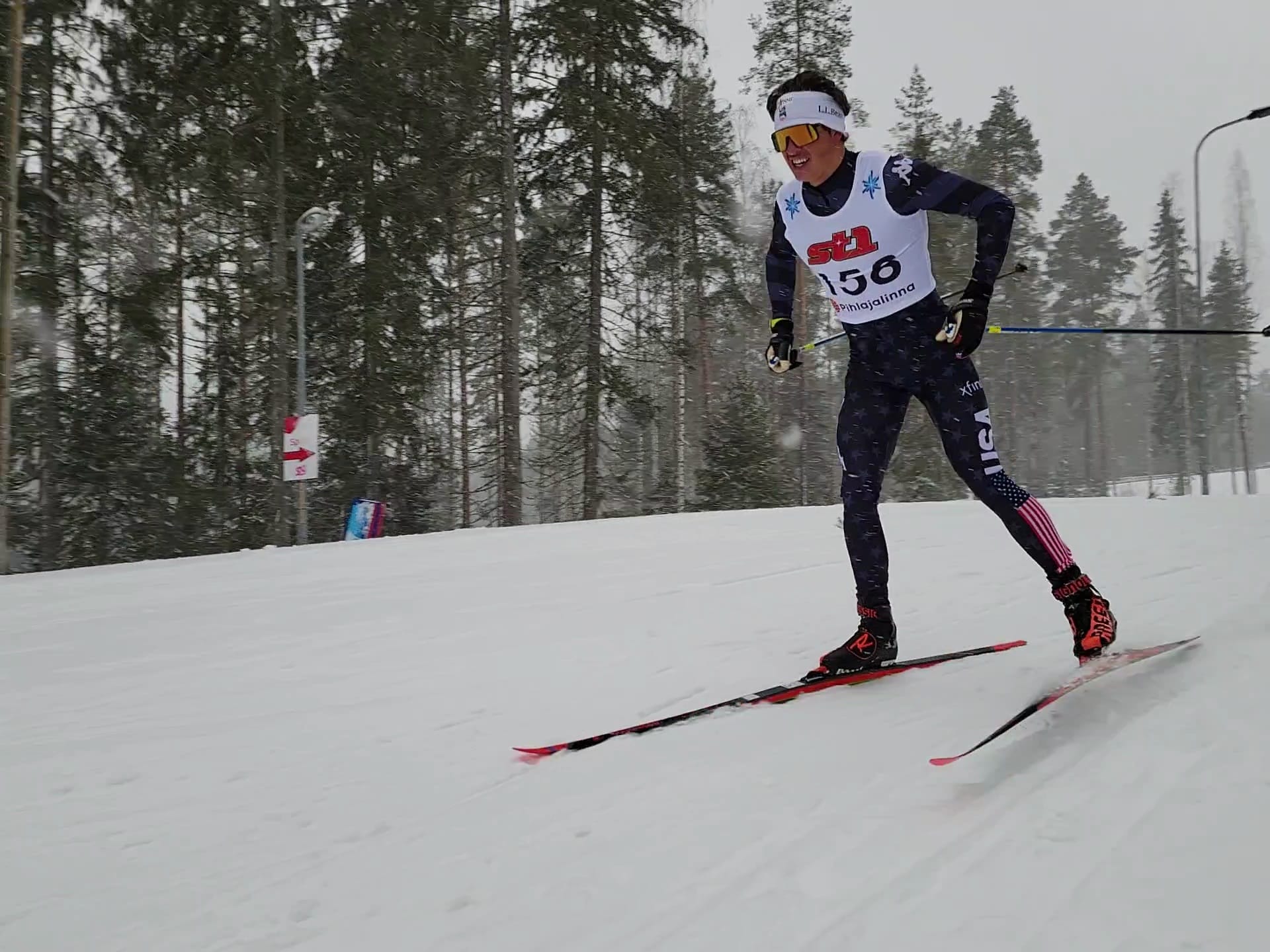
The race started out with a tight-knit pack, with stretches where Norway’s two teams looked to distinguish themselves from the pack. Bailey held though, keeping the pack together as he marked their moves and kept out of any potential tangles. His hand-off to Barbier saw the field in a pack. Through the second leg, a move from a Finnish team looked to break up the race permanently. Barbier was able to hold onto the chase group that remained behind, and keep the US in striking distance as the other teams ahead kept the pack tight. Barbier handed off to Greenberg with Team USA in sixth place.
Two kilometers into his leg, Greenberg was “30 seconds behind the race leader” said Will Wicherski, who was out on course. The Norwegian team in the pack had gone out ahead in the final lap. “We thought he would fight for a podium so [myself, and fellow coach Colin Rogers and Brandon Herhusky] skied back into the stadium. When the US coaches did make their way back to the stadium, a frantic scene greeted them. “We lost our minds when we saw Tabor come into the stadium with the Norwegian leader—he made 30 seconds on the leader in 3k!” Greenberg rounded the bend to close out an astounding leg. The Norwegian stumble beside him only let the US begin celebrations a split second early. “Seeing the USA beat Norway in a relay in Scandinavia was indescribable. It was a really great day for US skiing,” said coach Wicherski in the aftermath.
USA II finished 12th place after a strong anchor leg from Isom. The celebration of the historic result at the front of the race didn’t obscure the whole extent of the US’ success on the day, with coach Colin Rodger saying post-race that “the [USA 2] girls and boys teams [both were] energized by the top results, and I think we will see this group stepping up to be even stronger next year. [There is] a great positive feedback loop going here now.”
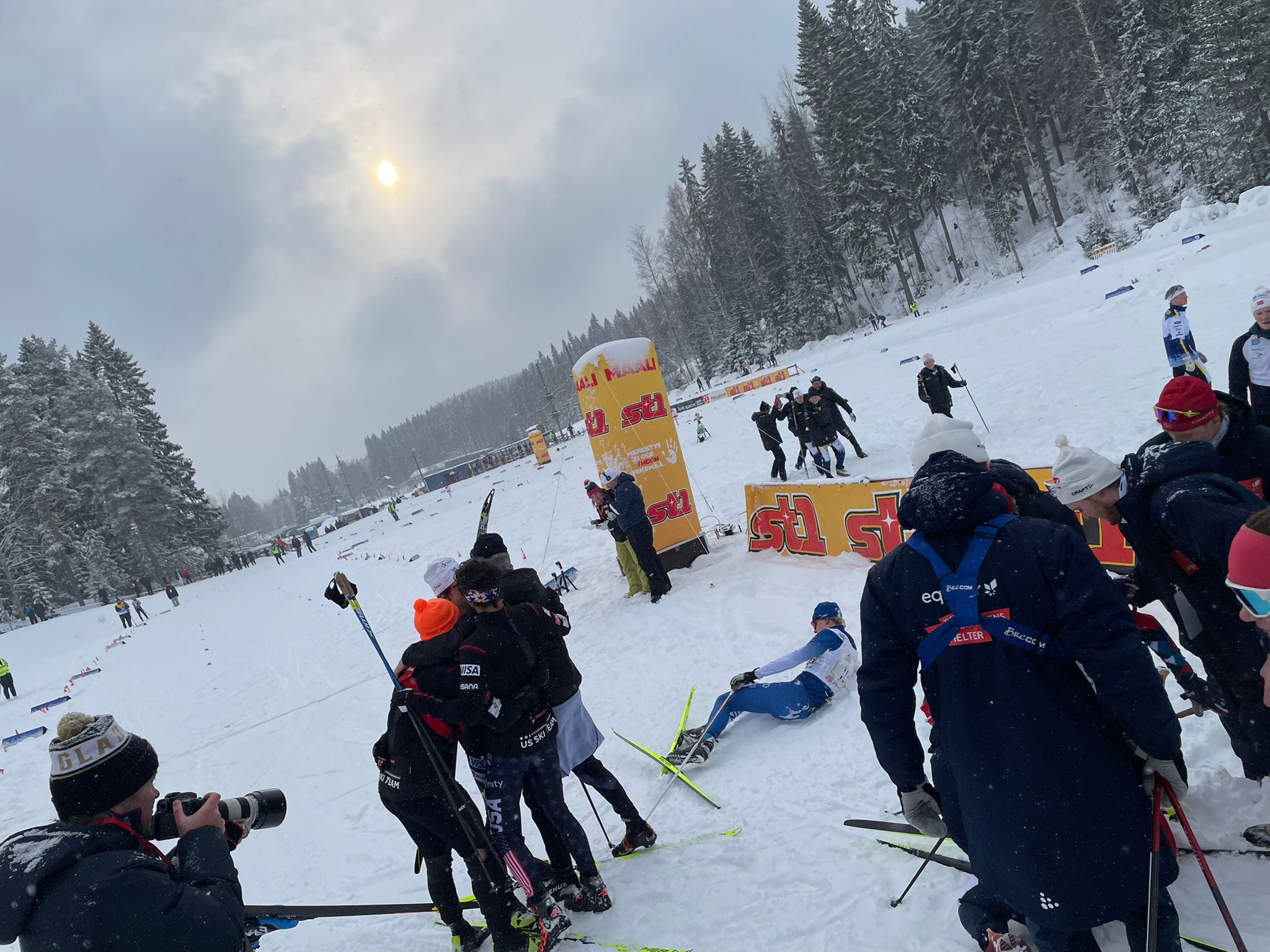
Conclusion
At the end of races Sunday, the caravan that accompanied Team USA made their way across the stadium in Jyvaskyla. Bailey, Barbier, and Greenberg took a first step onto the top step of an international podium. The US crowd let out a rousing cheer as they were announced, and some brave fans even took to tracing the tune of the “Star Spangled Banner” as it played through the stadium loudspeakers. As a team, and as individual skiers gathered from across the breadth of the US ski community, the trio looked forward together, with dreams and goals to chase.
With a trip through the Scandinavian peninsula for some sightseeing to follow, the journey continued for the young skiers who represented Team USA at this year’s Nordic Nations’ Cup. After their return to the United States, many are slated to head to Junior Nationals in Fairbanks to chase their own individual goals. Last weekend in Finland, though, they were banded together in a reminder of the connection between all of US skiing, now, and in its very near future. Simply put by US coach Colin Rodgers, “These kids will be friends for life after this experience and will no doubt be motivated by the success of the group.”
Full PHOTOSET from the National Nordic Foundation
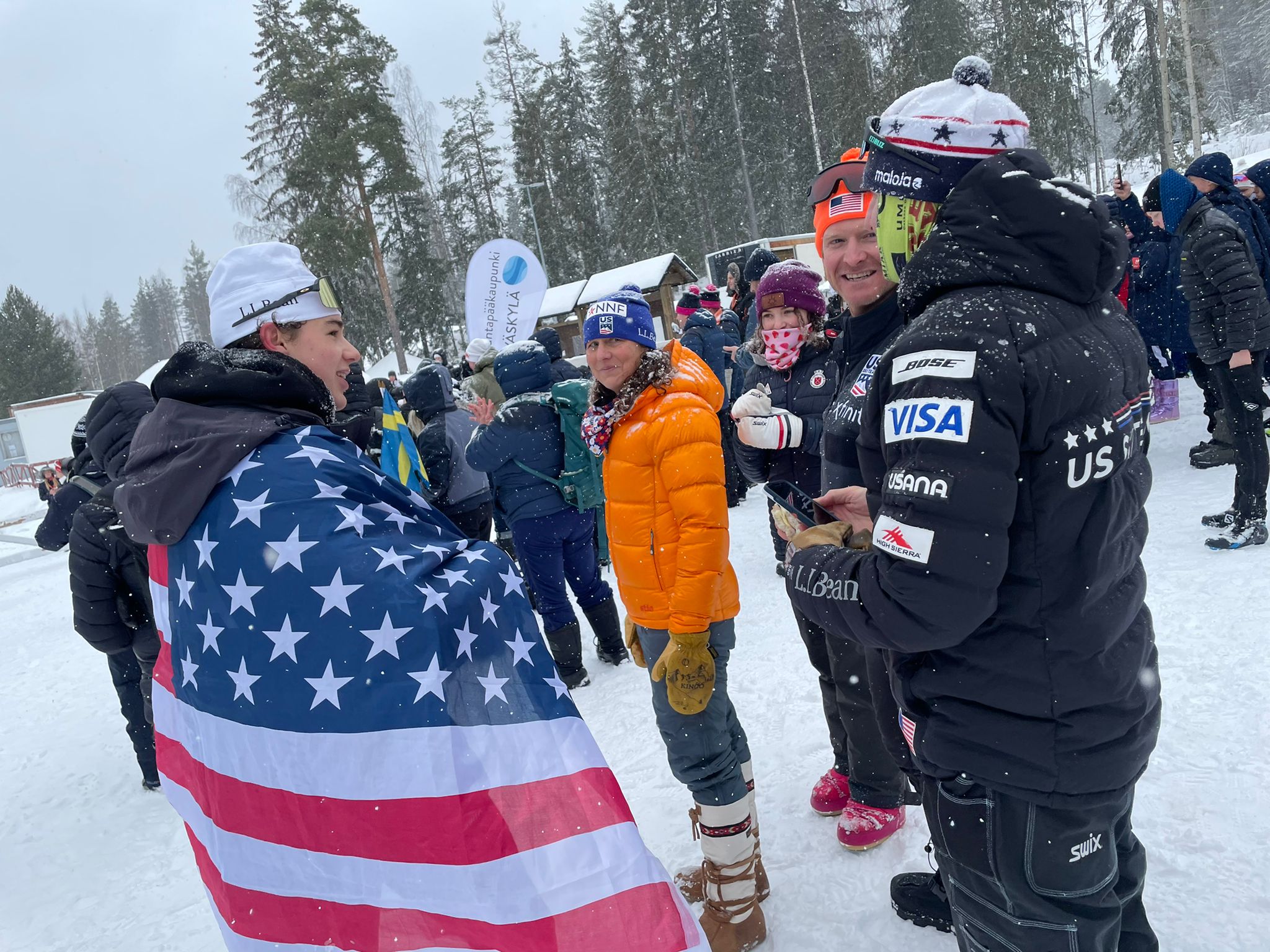
Ben Theyerl
Ben Theyerl was born into a family now three-generations into nordic ski racing in the US. He grew up skiing for Chippewa Valley Nordic in his native Eau Claire, Wisconsin, before spending four years racing for Colby College in Maine. He currently mixes writing and skiing while based out of Crested Butte, CO, where he coaches the best group of high schoolers one could hope to find.



